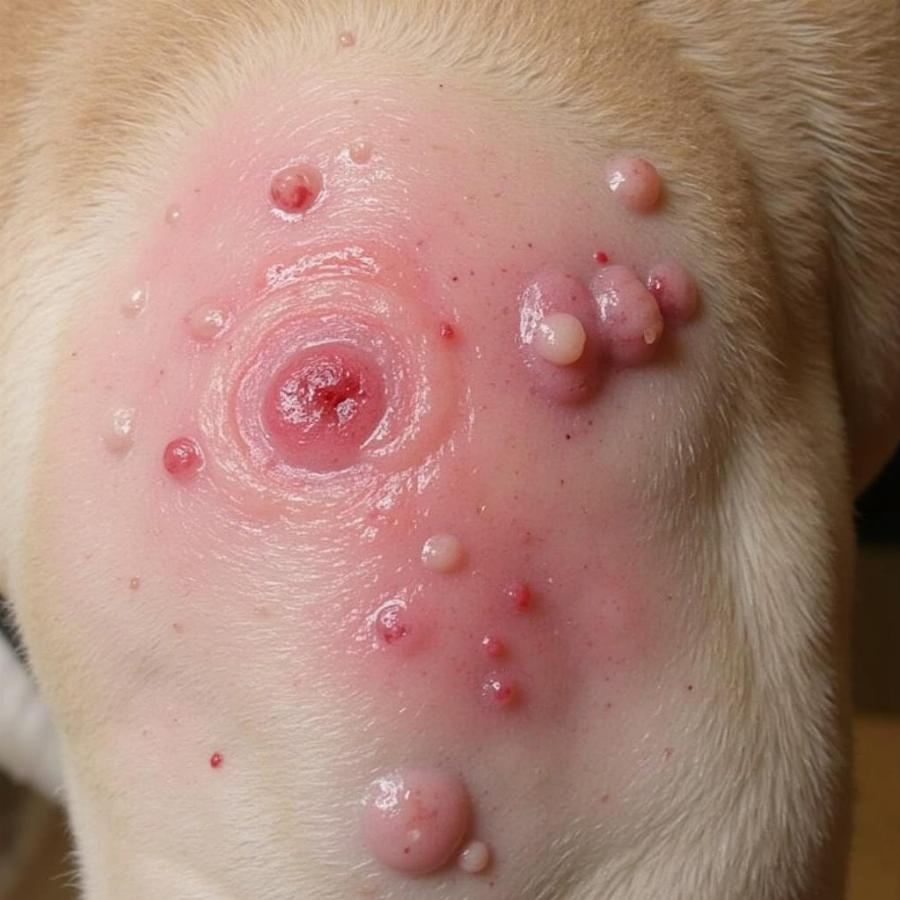Dog flea allergy is a common issue, particularly during warmer months. If your canine companion is excessively scratching, biting, or licking, they might be suffering from dog flea allergy dermatitis. This isn’t a reaction to the flea bite itself, but rather an allergic reaction to the flea’s saliva. Understanding the dog flea allergy symptoms is crucial for early diagnosis and effective treatment, ensuring your furry friend gets back to their happy, itch-free self.
Identifying Dog Flea Allergy Symptoms
So, how can you tell if your dog has a flea allergy? While the most obvious sign is intense itching, there are other key dog flea allergy symptoms to watch for. These include:
- Excessive scratching, biting, and licking: This is often focused on the base of the tail, back legs, and abdomen.
- Hair loss: Constant scratching and biting can lead to patches of missing fur.
- Red, inflamed skin: Look for areas of skin irritation, particularly around the areas they’re scratching.
- Scabs and sores: These can develop from excessive scratching and biting.
- Hot spots: These are moist, painful areas of inflamed skin that can become infected.
- Restlessness and discomfort: Your dog may seem agitated and unable to settle down.
 Chó Cảnh Bị Dị Ứng Bởi Nổi
Chó Cảnh Bị Dị Ứng Bởi Nổi
Is It Really a Flea Allergy? Ruling Out Other Causes
It’s important to note that these symptoms can also be indicative of other skin conditions. If you suspect your dog has a flea allergy, it’s essential to consult a veterinarian. They can accurately diagnose the issue and rule out other possibilities, such as:
- Other allergies: Dogs can be allergic to various environmental factors, like pollen, dust mites, and certain foods.
- Skin infections: Bacterial or fungal infections can cause similar skin irritation.
- Parasites: Mites and other parasites can cause intense itching.
Treating Dog Flea Allergy: A Multi-pronged Approach
Once your vet confirms a flea allergy, treatment usually involves a combination of approaches:
- Flea control: This is paramount. Your vet can recommend effective flea preventatives to kill existing fleas and prevent future infestations. This might include topical treatments, oral medications, or flea collars.
- Medication to relieve itching: Your vet might prescribe antihistamines or corticosteroids to reduce inflammation and itching.
- Soothing shampoos and sprays: These can help soothe irritated skin and provide temporary relief.
- Addressing secondary infections: If your dog has developed a secondary skin infection due to scratching, antibiotics or antifungals might be necessary.
Preventing Flea Allergies: Proactive Steps for a Happy Dog
Preventing flea infestations is the best way to manage flea allergies. Here are some proactive steps you can take:
- Regular flea prevention: Use a vet-recommended flea preventative year-round, even in colder months.
- Frequent grooming: Regularly brushing your dog can help you detect fleas early on.
- Cleaning your home: Vacuum frequently, wash pet bedding regularly, and consider using flea sprays or foggers in your home environment.
- Treating your yard: If your dog spends time outdoors, consider treating your yard with a flea and tick control product.
Living with a Flea Allergy: Long-Term Management
Managing a dog flea allergy is an ongoing process. While complete eradication of the allergy isn’t always possible, with consistent flea control and appropriate veterinary care, you can significantly reduce your dog’s discomfort and improve their quality of life.
Conclusion: Giving Your Dog Relief from Flea Allergy Symptoms
Recognizing dog flea allergy symptoms and seeking prompt veterinary care is crucial for effectively managing this common condition. By understanding the signs, implementing a comprehensive flea control strategy, and working closely with your vet, you can help your furry friend live a comfortable, itch-free life.
FAQs: Common Questions about Dog Flea Allergies
- Can dogs outgrow flea allergies? Unfortunately, it’s rare for dogs to outgrow flea allergies. Consistent flea control is typically necessary throughout their lives.
- How quickly do flea allergy symptoms appear? Symptoms can appear within minutes to hours of a flea bite.
- Are certain dog breeds more prone to flea allergies? While any breed can develop a flea allergy, some breeds might be slightly more predisposed.
- What is the best flea preventative for allergic dogs? Consult your veterinarian for the most suitable flea preventative for your dog’s individual needs.
- Can flea allergies be cured? There’s no cure for flea allergies, but they can be effectively managed.
- What home remedies can soothe itchy skin? While some home remedies might offer temporary relief, always consult your vet before trying any at-home treatments.
- How often should I bathe my dog with flea allergy? Consult your vet for the appropriate bathing frequency, as over-bathing can dry out the skin.
More Helpful Resources for Dog Owners
Beaut Dogs is your go-to resource for all things related to dog care, providing expert advice and information on various breeds, health issues, and training tips. itching paws in dogs For further assistance or personalized advice on dog flea allergy symptoms, please contact us via Email at [email protected]. Beaut Dogs is dedicated to helping you provide the best possible care for your beloved companion. will pyrethrin 5 or neem oil kill my dog’s fleas We offer a wealth of knowledge and resources to support you on your journey as a dog owner.